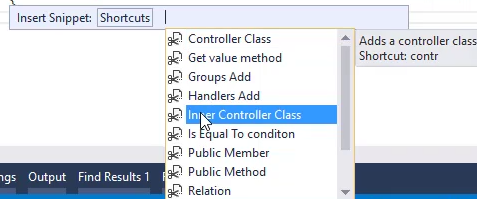Adding an Inner Class
- Previously we created a separate BusinessProcess to collect the statistics of our order, now we'll use an inner class to achieve the same results
- An inner class is a class that is defined within the scope of it's container class.
- In the following code the class called
myInnerClassis considered an inner class, since it is defined within the scope of it's container classShowOrdersToDemoInnerClassesclass
public class ShowOrdersToDemoInnerClasses : UIControllerBase
{
public readonly Models.Orders Orders = new Models.Orders();
public readonly NumberColumn Items = new NumberColumn("Items", "2");
public readonly NumberColumn TotalQuantity = new NumberColumn("Total Quantity", "4");
public readonly NumberColumn TotalAmount = new NumberColumn("Total Amount", "5C");
public ShowOrdersToDemoInnerClasses()
{
From = Orders;
}
public void Run()
{
Execute();
}
protected override void OnLoad()
{
View = () => new Views.ShowOrdersToDemoInnerClassesView(this);
}
class myInnerClass
{
}
} - To quickly create an inner class, we'll use the "Inner Controller Class" snippet (
contrin short)

- Will determine:
- The name of the inner class - in our case "GetTotals"
- The base class - on our case
BusinessProcessBasewhich is the default - The Container class - in our case
ShowOrdersToDemoInnerClasses
- Here's the result
public class ShowOrdersToDemoInnerClasses : UIControllerBase
{
public readonly Models.Orders Orders = new Models.Orders();
public readonly NumberColumn Items = new NumberColumn("Items", "2");
public readonly NumberColumn TotalQuantity = new NumberColumn("Total Quantity", "4");
public readonly NumberColumn TotalAmount = new NumberColumn("Total Amount", "5C");
public ShowOrdersToDemoInnerClasses()
{
From = Orders;
}
public void Run()
{
Execute();
}
protected override void OnLoad()
{
View = () => new Views.ShowOrdersToDemoInnerClassesView(this);
}
class GetTotals : BusinessProcessBase
{
ShowOrdersToDemoInnerClasses _parent;
public GetTotals(ShowOrdersToDemoInnerClasses parent)
{
_parent = parent;
}
public void Run()
{
Execute();
}
protected override void OnLoad()
{
}
}
} - Note that it's getting the parent controller as a parameter to it's constructor, and stores it in a field called
_parentwhich we cal later use to access the parent controller. - Here is how we call our inner controller
public class ShowOrdersToDemoInnerClasses : UIControllerBase
{
public readonly Models.Orders Orders = new Models.Orders();
public readonly NumberColumn Items = new NumberColumn("Items", "2");
public readonly NumberColumn TotalQuantity = new NumberColumn("Total Quantity", "4");
public readonly NumberColumn TotalAmount = new NumberColumn("Total Amount", "5C");
public ShowOrdersToDemoInnerClasses()
{
From = Orders;
}
public void Run()
{
Execute();
}
protected override void OnLoad()
{
View = () => new Views.ShowOrdersToDemoInnerClassesView(this);
}
protected override void OnEnterRow()
{
new GetTotals(this).Run();
}
class GetTotals : BusinessProcessBase
{
ShowOrdersToDemoInnerClasses _parent;
public GetTotals(ShowOrdersToDemoInnerClasses parent)
{
_parent = parent;
}
public void Run()
{
Execute();
}
protected override void OnLoad()
{
}
}
} - Note that when we call it, we are sending
thisas a parameter to it's constructor. This means that we are sending the parent controller as a parameter to the inner controller. Later we'll be able to use that_parenton our inner controller, to access fields in theparentcontroller.
Help us improve, Edit this page on GitHub
or email us at info@fireflymigration.com
